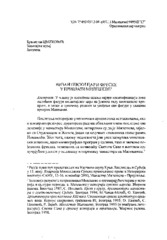Приказ основних података о документу
Byzantine emperor and frescoes in Mileševa narthex
Византијски цар и фреске у припрати Милешеве
| dc.creator | Cvetković, Branislav | |
| dc.date.accessioned | 2018-11-09T13:11:11Z | |
| dc.date.available | 2018-11-09T13:11:11Z | |
| dc.date.issued | 2002 | |
| dc.identifier.issn | 0350-7653 | |
| dc.identifier.uri | https://dais.sanu.ac.rs/123456789/4139 | |
| dc.description.abstract | The unique appearance of the portrait of an unknown monarch in Byzantine emperor attire on the south wall of Mileševa narthex, painted opposite the figure of Stephen the First-Crowned, attracted much attention of researchers in the previous period. In search for the identity of the damaged figure of a Byzantine emperor, a series of suggestions were made, ranging from the idea that it was an image of one of the Byzantine emperors, Alexis III Angelus, Theodore I Lascaris or John III Ducas Vatatzes, to the opinions that it was Bulgarian emperor Ivan II Asen or Serbian King Vladislav, painted in Mileševa for the third time. In scientific thought in recent years, the suggestion of Professor V. J. Djurić was predominant, namely that the image of an unknown emperor should be deemed to be the portrait of Emperor John III Ducas Vatatzes of Nicaea. The reason for belief that the portrait of this monarch was included in the iconographic program of Mileševa originated from specific political circumstances of new Serbian kingdom in early 13th century. Thus, the portrait of John Ducas was believed to be a reflection of specific political relationships and a special legal status of Serbia towards the empire of Nicaea in the context of strife for autocephality of Serbian church. In this paper a different explanation has been suggested, based on the iconographic, historical, and insignia analysis. The earlier hypothesis has been accepted, namely that the image of a Byzantine emperor should be the portrait of Alexis III Angelus. The importance of this Byzantine emperor for the first generation of the Nemanjićs, ideological patterns used in recounting diplomatic and military achievements of Serbia at the end of 12th and beginning of 13th centuries, recurring mentions of Alexis in several written Serbian sources, analogy with the portraits in Hilandar (King Milutin and Emperor Andronicus), as well as Chronism of emperor’s attire and insignia, all quite decisively contribute to the hypothesis that opposite of Stephen the First-Crowned in Mileševa only his father-in-law, Emperor Alexis III Angelus, could have been painted. | en |
| dc.description.abstract | U članku je posvećena pažnja najpre identifikaciji lika oštećene figure vizantijskog cara na južnom zidu mileševske priprate, a zatim i tumačenju razloga za uvođenje ove figure slikani program Mileševe. | sr |
| dc.rights | openAccess | |
| dc.rights.uri | https://creativecommons.org/licenses/by-nc-sa/4.0/ | |
| dc.source | Balcanica | |
| dc.title | Byzantine emperor and frescoes in Mileševa narthex | en |
| dc.title | Византијски цар и фреске у припрати Милешеве | sr |
| dc.type | article | |
| dc.rights.license | BY-NC-SA | |
| dcterms.abstract | Цветковић Бранислав; Vizantijski car i freske u priprati Mileševe; | |
| dc.citation.spage | 297 | |
| dc.citation.epage | 310 | |
| dc.citation.issue | 32-33 | |
| dc.identifier.doi | 10.2298/BALC0233297C | |
| dc.type.version | publishedVersion | en |
| dc.identifier.fulltext | https://dais.sanu.ac.rs/bitstream/id/21098/4250.pdf | |
| dc.citation.other | (32-33): 297-310 | |
| dc.identifier.rcub | https://hdl.handle.net/21.15107/rcub_dais_4139 |

